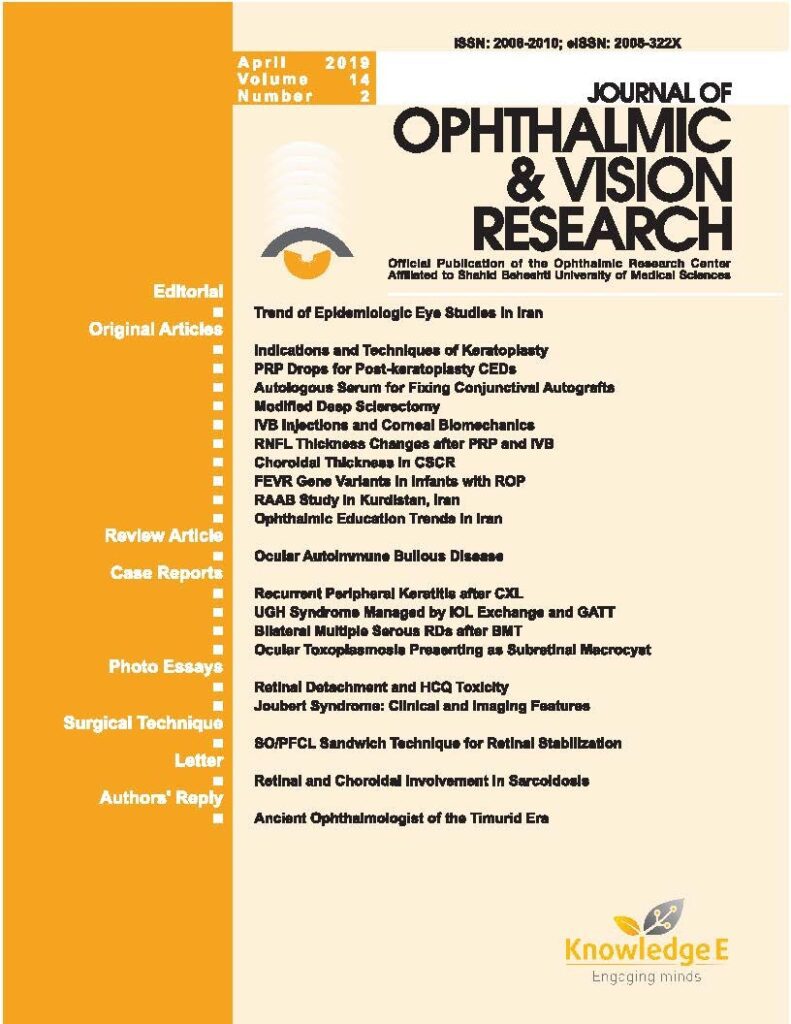
Journal of Ophthalmic and Vision Research
ISSN: 2008-322X
The latest research in clinical ophthalmology and the science of vision.
Rituximab Monotherapy versus Rituximab and Bortezomib Combination Therapy for Treatment of Non-paraneoplastic Autoimmune Retinopathy
Published date: Nov 24 2022
Journal Title: Journal of Ophthalmic and Vision Research
Issue title: Oct–Dec 2022, Volume 17, Issue 4
Pages: 515 – 528
Authors:
Abstract:
Purpose: To study whether rituximab and bortezomib combination therapy is more effective than rituximab monotherapy in the treatment of nonparaneoplastic autoimmune retinopathy (npAIR).
Methods: Retrospective case series involving six patients with npAIR, taking either rituximab and bortezomib combination therapy (three cases) or rituximab monotherapy (one case and two historical patients).
Results: Patients on both treatment regimens showed stability in most of the visual function parameters during the one year of follow-up. Combination therapy resulted in improvement of scotopic combined rod and cone a-wave and b-wave amplitudes in all eyes where they were available (four eyes); however, rituximab monotherapy resulted in only two eyes with stable scotopic combined rod and cone a-wave and b-wave amplitudes, while four eyes showed a decrease in both a- and b-wave amplitudes. The average improvement in b-wave amplitude (50.7% ± 29.4% [range 25–90%]) was higher than the average improvement in awave amplitude (35.7% ± 9.74 [range 25–63%]). No severe adverse effects were reported.
Conclusion: Rituximab and bortezomib combination therapy may not be more effective than rituximab monotherapy in npAIR patients for most of the visual function parameters; however, this combination therapy may be more effective in improving scotopic combined rod and cone a- and b-wave amplitudes. This may indicate the higher efficacy of combination therapy when there is involvement of the inner retina.
Keywords: Autoimmune Retinopathy, Bortezomib, Electroretinography, Nonparaneoplastic AIR, Rituximab, Visual Field
References:
1. Mizener JB, Kimura AE, Adamus G, Thirkill CE, Goeken JA, Kardon RH. Autoimmune retinopathy in the absence of cancer. Am J Ophthalmol 1997;123:607–618.
2. Takiuti JT, Takahashi VK, Xu CL, Jauregui R, Tsang SH. Non-paraneoplastic related retinopathy: Clinical challenges and review. Ophthalmic Genet 2019;40:293–297.
3. Grange L, Dalal M, Nussenblatt RB, Sen HN. Autoimmune retinopathy. Am J Ophthalmol 2014;157:266–272.e1.
4. Sobrin L. Progress toward precisely diagnosing autoimmune retinopathy. Am J Ophthalmol 2018;188:xiv– xv.
5. Boudreault K, Justus S, Sengillo JD, Schuerch K, Lee W, Cabral T, et al. Efficacy of rituximab in non-paraneoplastic autoimmune retinopathy. Orphanet J Rare Dis 2017;12:129.
6. Fox AR, Gordon LK, Heckenlively JR, Davis JL, Goldstein DA, Lowder CY, et al. Consensus on the diagnosis and management of nonparaneoplastic autoimmune retinopathy using a modified delphi approach. Am J Ophthalmol 2016;168:183–190.
7. Maleki A, Lamba N, Ma L, Lee S, Schmidt A, Foster CS. Rituximab as a monotherapy or in combination therapy for the treatment of non-paraneoplastic autoimmune retinopathy. Clin Opthalmol 2017;11:377–385.
8. Fox A, Jeffrey B, Hasni S, Nussenblatt R, Sen HN. Rituximab treatment for nonparaneoplastic autoimmune retinopathy. Can J Ophthalmol 2015;50:e101–104.
9. Davoudi S, Ebrahimiadib N, Yasa C, Sevgi DD, Roohipoor R, Papavasilieou E, et al. Outcomes in autoimmune retinopathy patients treated with Rituximab. Am J Ophthalmol 2017;180:124–132.
10. Uludag G, Onal S, Arf S, Sayman Muslubas I, Selcukbiricik F, Koc Akbay A, et al. Electroretinographic improvement after rituximab therapy in a patient with autoimmune retinopathy. Am J Ophthalmol Case Rep 2016;2:4–7.
11. Armbrust KR, Fox AR, Jeffrey BG, Sherry P, Sen HN. Rituximab for autoimmune retinopathy: Results of a Phase I/II clinical trial. Taiwan J Ophthalmol 2020;11:64–70.
12. Russo A, Fratto ME, Bazan V, Schiró V, Agnese V, Cicero G, et al. Targeting apoptosis in solid tumors: The role of bortezomib from preclinical to clinical evidence. Expert Opin Ther Targets 2007;11:1571–1586.
13. Benson MD, Plemel DJ, Yacyshyn E, Sandhu I, MacDonald IM, Baker CF. Combination treatment with Rituximab and Bortezomib in a patient with non-paraneoplastic autoimmune retinopathy. Ocul Immunol Inflamm 2020;28:958–965.
14. Adamus G, Ren G, Weleber RG. Autoantibodies against retinal proteins in paraneoplastic and autoimmune retinopathy. BMC Ophthalmol 2004;4:5.
15. McCulloch DL, Marmor MF, Brigell MG, Hamilton R, Holder GE, Tzekov R, et al. ISCEV Standard for fullfield clinical electroretinography (2015 update). Doc Ophthalmol 2015;130:1–12.
16. Cao JH, Oray M, Cocho L, Foster CS. Rituximab in the treatment of refractory noninfectious scleritis. Am J Ophthalmol 2016;164:22–28.
17. Mohan M, Matin A, Davies FE. Update on the optimal use of bortezomib in the treatment of multiple myeloma. Cancer Manag Res 2017;9:51–63.
18. Fishman GA, Chappelow AV, Anderson RJ, Rotenstreich Y, Derlacki DJ. Short-term inter-visit variability of erg amplitudes in normal subjects and patients with retinitis pigmentosa. Retina 2005;25:1014–1021.
19. Mills RP, Budenz DL, Lee PP, Noecker RJ, Walt JG, Siegartel LR, et al. Categorizing the stage of glaucoma from pre-diagnosis to end-stage disease. Am J Ophthalmol 2006;141:24–30.
20. Simon R. Optimal two-stage designs for phase II clinical trials. Control Clin Trials 1989;10:1–10.
21. Khanna S, Martins A, Oakey Z, Mititelu M. Nonparaneoplastic autoimmune retinopathy: Multimodal testing characteristics of 13 cases. J Ophthalmic Inflamm Infect 2019;9:6.
22. Adamus G. Are Anti-Retinal Autoantibodies a cause or a consequence of retinal degeneration in autoimmune retinopathies? Front Immunol 2018;9:765.
23. Garcia CM, Maleki A, Look-Why S, Manhapra A, Durrani K, Foster CS. Non-paraneoplastic autoimmune retinopathy versus Pericentral Retinal Degeneration phenotype: Which came first? A case report. Retin Cases Brief Rep 2021. Publish Ahead of Print: https://doi.org/10.1097/ICB.0000000000001199